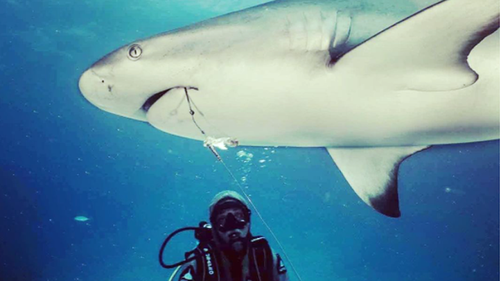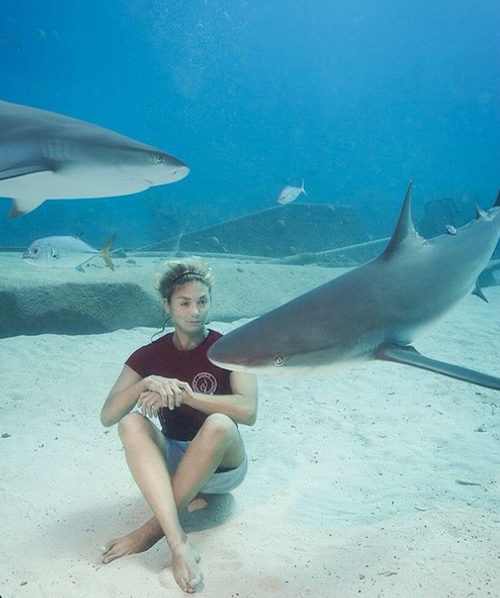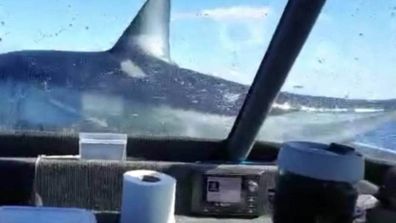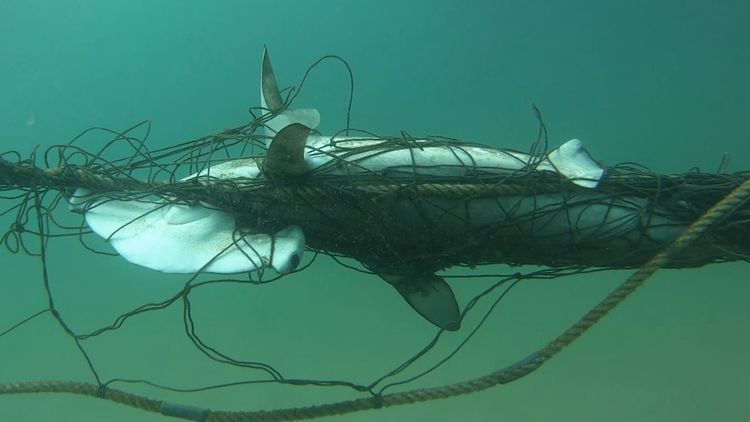How To Remove Hook From Shark
In the crystal clear waters of the Commonwealth of the bahamas one diver is doing what near people would baulk at — she'south approaching wild sharks , sticking her arm down their mouths and removing embedded hooks.
Cristina Zenato had been diving in the island nation, which is off the coast of Cuba, for three decades and has always been fascinated past the sea .
After seeing sharks in visible distress she told 9news.com.au she decided to do something.

"(They'd have) swollen jaws, or I watched them slam themselves in the sand trying to remove it," she said, calculation it was a natural progression to start removing the hooks.
"It's the aforementioned way I would remove a thorn out of my canis familiaris'due south paw."
Obviously, don't endeavour this at abode.
It was the removal of a hook from a Caribbean reef shark called "Foggy Center" that still sticks with Ms Zenato.

"She never liked to be touched, she'd never approach," she said.
"One day she showed up with a hook on the side and as she was swimming by I grabbed it and it came out easily.
"Three days afterward she showed up with some other. I couldn't run across the hook I could only meet the lure coming out of her mouth.
"I started working with her and after a 30 minute dive I literally shoved my arm down her oral fissure up to the elbow and pulled this hook out.
"From that day on she always likes to be patted. She volition come lean into me, come into my lap and allow me to pat her.
"It was really a 180 degree behavioural change."
Ms Zenato has formed such a shut bond with the "smart" animals she claims they actually started seeking her out for help.

While the diver wishes she could help all species, she predominantly performs removals on Caribbean reef sharks and nurse sharks.
She explained that the size of larger species, such as tiger sharks and bull sharks, makes removals near-impossible.

Shark leaps onto front of boat during fishing trip
"They're just likewise large. Size does matter in this case," she said.
"If a tiger merely tries to motion away from me information technology could actually knock me off past a couple of feet.
"Unless I was extremely comfy with a specific animate being I wouldn't go effectually trying to remove hooks."
'The deadliest grade of plastic pollution'
Commonwealth of australia's scientific research agency CSIRO estimates that more than a quarter of the world'southward angling lines are lost every year.
Researchers sifted through 40 years of data to produce the kickoff global guess of commercial angling gear losses.

"The study estimates that 6 per cent of all angling nets, 9 per cent of all traps, and 29 per cent of all lines are lost or discarded into our oceans each yr," Kelsey Richardson, a PhD educatee from CSIRO's Marine Debris Team , who led the written report, said in a statement.
"We found that bad weather, gear becoming ensnared on the seafloor, and gear interfering with other gear types are the most mutual reasons for commercial fishing gear being lost."
Discarded fishing gear is the deadliest form of marine plastic pollution every bit it leads to death by exhaustion or suffocation.

"Discarded nets, lines, and ropes now make upward virtually 46 per cent of the Corking Pacific Garbage Patch," the World Wildlife Fund (WWF) states.
Once in the bounding main, angling gear can take hundreds of years to breakup.
Source: https://www.9news.com.au/world/fearless-diver-dedicates-life-to-removing-fish-hooks-from-the-mouths-of-wild-sharks/64acf651-bc42-451e-a875-0a53e2f2f4c5

0 Response to "How To Remove Hook From Shark"
Post a Comment